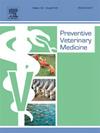Foot pad dermatitis in broiler chickens – effects of hybrid and weather conditions
IF 2.4
2区 农林科学
Q1 VETERINARY SCIENCES
引用次数: 0
Abstract
Foot pad dermatitis (FPD) is a common animal welfare challenge in indoor broiler production. This cross-sectional study investigated the effect of outdoor weather conditions (temperature and precipitation) and hybrid (fast-growing Ross 308 [Ross] vs. slower-growing Hubbard JA787 [Hubbard]) on the prevalence of FPD at slaughter. The study included 420,300 broilers from 4203 commercial flocks, raised in 139 farms in Central Norway and slaughtered in the period from January 1st, 2015, to June 22nd, 2021. The apparent prevalence of mild/moderate FPD and severe FPD, respectively, was 14.06 % and 5.80 % in Ross broilers and 5.72 % and 1.64 % in Hubbard broilers. The effect of hybrid and weather conditions on the prevalence of FPD was estimated using hierarchical multinomial models. At sample mean weather conditions, the risk of mild/moderate FPD and severe FPD were 2.8 (95 % CI: 2.2;3.7) and 5.8 (95 % CI: 3.1;10.7) times higher for Ross than Hubbard broilers, respectively. Sensitivity analyses indicated that these estimates were relatively robust; yet the protective effect of being Hubbard may be slightly overestimated. For both hybrids, the risk of FPD was affected by the weather, and cold weather combined with a precipitation level at the sample mean yielded the highest risk of severe FPD. Hubbard broilers were less sensitive to weather conditions compared to Ross with respect to FPD occurrence. The results from this study add to the growing evidence that the choice of hybrid impacts the health-related aspects of animal welfare in commercial broiler production systems.
肉鸡脚垫皮炎——杂交和天气条件的影响
脚垫皮炎(FPD)是室内肉鸡生产中常见的动物福利问题。这项横断面研究调查了室外天气条件(温度和降水)和杂交(生长迅速的Ross 308 [Ross]与生长较慢的Hubbard JA787 [Hubbard])对屠宰时FPD患病率的影响。该研究包括来自挪威中部139个农场的4203只商业鸡群的420,300只肉鸡,这些鸡在2015年1月1日至2021年6月22日期间被屠宰。罗斯肉鸡轻/中度FPD和重度FPD的表观患病率分别为14.06 %和5.80 %,哈伯德肉鸡为5.72 %和1.64 %。利用层次多项式模型估计了杂交和天气条件对FPD患病率的影响。在样本平均天气条件下,罗斯肉鸡轻度/中度FPD和重度FPD的风险分别比哈伯德肉鸡高2.8倍(95 % CI: 2.2;3.7)和5.8倍(95 % CI: 3.1;10.7)。敏感性分析表明,这些估计是相对稳健的;然而,哈伯德的保护作用可能被略微高估了。对于这两个杂交品种,FPD的风险都受到天气的影响,寒冷的天气加上样本平均值的降水量产生严重FPD的风险最高。与罗斯相比,哈伯德肉鸡对FPD发生的天气条件不太敏感。这项研究的结果进一步证明,选择杂交品种会影响商业肉鸡生产系统中动物福利的健康方面。
本文章由计算机程序翻译,如有差异,请以英文原文为准。
求助全文
约1分钟内获得全文
求助全文
来源期刊

Preventive veterinary medicine
农林科学-兽医学
CiteScore
5.60
自引率
7.70%
发文量
184
审稿时长
3 months
期刊介绍:
Preventive Veterinary Medicine is one of the leading international resources for scientific reports on animal health programs and preventive veterinary medicine. The journal follows the guidelines for standardizing and strengthening the reporting of biomedical research which are available from the CONSORT, MOOSE, PRISMA, REFLECT, STARD, and STROBE statements. The journal focuses on:
Epidemiology of health events relevant to domestic and wild animals;
Economic impacts of epidemic and endemic animal and zoonotic diseases;
Latest methods and approaches in veterinary epidemiology;
Disease and infection control or eradication measures;
The "One Health" concept and the relationships between veterinary medicine, human health, animal-production systems, and the environment;
Development of new techniques in surveillance systems and diagnosis;
Evaluation and control of diseases in animal populations.
 求助内容:
求助内容: 应助结果提醒方式:
应助结果提醒方式:


